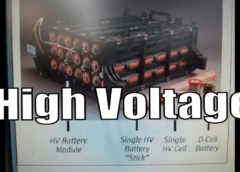OK, we are working on a honda civic hybrid with some high voltage battery codes along with some charging system problems with the accessory battery. This video is packed with some great diagnostic info on these honda civic hybrid system with trouble codes P1570 or P0A7F
Vehicle Application:
2006 Civic 1.3
2007 Civic 1.3
2008 Civic 1.3
2009 Civic 1.3
Customer Concern: The check engine light and IMA light are on with code P0A7F, indicating the High Voltage (HV) battery module has deteriorated.
Average Reported Mileage: 140294
Tests/Procedures: 1. Refer to Honda Technical Service Bulletin (TSB) 09-025. This code indicates the High Voltage (HV) battery is failing and will need to be replaced. Then the vehicle will need to be reflashed. Also, Honda has extended the warranty on the battery, refer to TSB 12-077.
2. Perform AR&D Battery Test to locate the weak battery cell.
Vehicle Application:
2003 Civic 1.3
2004 Civic 1.3
2005 Civic 1.3
2006 Civic 1.3
2007 Civic 1.3
2008 Civic 1.3
Customer Concern: The check engine light is on and there is a code P1570 indicating a code for the HV battery individual voltage problem.
Average Reported Mileage: 110373
Tests/Procedures: 1. To properly test this code you will need the correct scan tool to look at the HV battery blocks and look for a voltage difference. Honda has a High failure rate on the HV battery and has extended the warranty.
Okay, Flat Rate Mechanic here today we’re going to be diagnosing our check engine light and a battery light on this 2006 Honda Civic Hybrid.
We’ve got a couple of stored codes. We have a p1570and a p0a7f which are both pertaining to the high voltage battery pack for this hybrid. So basically we’re gonna go in, I have the factory Honda scan tool hooked up to this right now.
We’re going to go ahead and connect to this vehicle. We’re going to pull codes and take a look at the high voltage battery cells to see If we have a bad cell. If we do we’re going to have to replace it. I’m gonna show you where the high voltage battery pack is, how to turn it on and off.
I also did a little research on this. I’ll give you some diagnostic tips that I found on Identifix. There’s also an updated warranty information I will give you towards the end of this video. They have extended the warranty on high voltage batteries. They’re having a lot of problems with them.
So I’m all into the scan tool here, we’re gonna go ahead and access the electronic powertrain. From here we will go ahead and go to the data list. We’re gonna see if we can look at the voltages in this battery pack and make sure all the cells are functioning properly. This is a pretty easy check to do if you have a scan tool that can read engine data.
Go down to IMA battery module one two three all the way up to 11 and we’re just looking at these voltages. They’re all about 15 volts so that’s actually not looking that bad and that’s all normal at the moment in my opinion. Probably what I’m gonna do next is do a starting and charging system test.
On the test drive, I also had a battery light on on the dash, so I’m gonna go ahead do it starting and charging test make sure to the DC to DC converter is charging the 12-volt accessory battery.
If all that tests well I’m probably gonna come back and revisit this high voltage battery and take a little deeper dive into this and see if I can see any problems with that.
All right um let’s take a look at some of this information that I pulled. Like I said extending the warranty on this. Honda has a high failure rate on HP battery and has extended its warranty. Here is the extended warranty information. It looks like they’ve extended it 11 years 170,000 miles years 162,000 miles.
So pretty good coverage as far as this high voltage battery goes but I’m suspecting this vehicle is not gonna need that. I think we have a charging problem. Well, I guess where this is a hybrid, this car does not have an alternator it just has a DC to DC converter that charges a battery with the high voltage battery.
Where we have a battery light on in the dash I’m definitely suspecting we got a charging problem. I’m going to go underneath the hood here in a minute and test that but I want to show a few pictures of where the battery is located and also where the DC to DC converter is located.
Where is the high voltage battery and the DC to DC converter?
It’s going to be behind the rear seat. You’re going to have your switch and access panel to the right you have to remove the bolt and you can shut it off all power to the rest of the system from the high voltage battery. Witch you will always want to do before any testing or servicing.
To service this module as you can see there’s an access panel behind the rear seat that is gonna be removed to get to the high voltage battery and the DC converter. It’s fairly easy to access.
We’re gonna go under the hood here and see if we’re getting voltage to this accessory battery. As you can see on our battery tester we’re only on 11.6 volts which just means this battery is discharging right now, it’s not charging. So I’m suspecting we have a DC to DC converter issue.
I’m going to access the DC to DC converter and make sure all of the connections are tight and clean. If all that checks out pretty good this car is going to need a DC to DC converter.
Also when I was looking at the service information I was also able to find that they’re having issues too. The is a service bulletin on the wires getting pinched in the rear trunk and there’s is a hundred amp fuse that blows when this happens so we’re gonna check that as well, once we get the rear seat taken out.
I’m suspecting, in this case, but probably not every case this high voltage battery pack is gonna be OK. We’re gonna go after the DC to DC converter.
Okay so I want to take a second look at this voltage and it’s continuing to drop so I’ve determined that this thing definitely needs a DC to DC converter in order to get this axillary battery charging again. We’re also gonna put a new battery in this as it was also testing bad.
I’ll also leave some other diagnostic information and some tips and tricks on how to diagnose these HV or high voltage batteries on this hybrid Honda Civics. Seems like they’re starting to be pretty big issues as these vehicles get of age. Typically 180 to 200 thousand miles.
Until next time Flat Rate Mechanic!








O2 sensor and Air Fuel sensors Look the same but work Differently.
Using Fuel Trim Data to Diagnose a P0420 code (Rich or Lean Condition)
Leaking Exhaust or Bad Catietic Converter?
After Market Catiletic Converters VS OEM
Response: